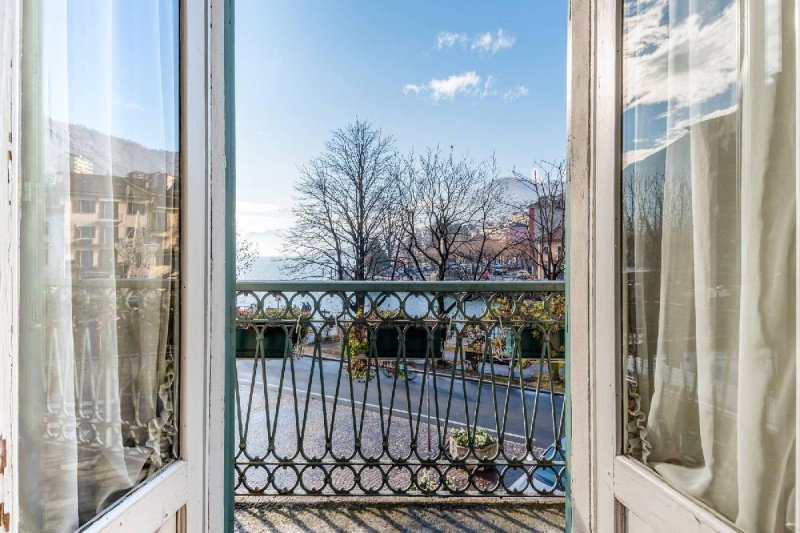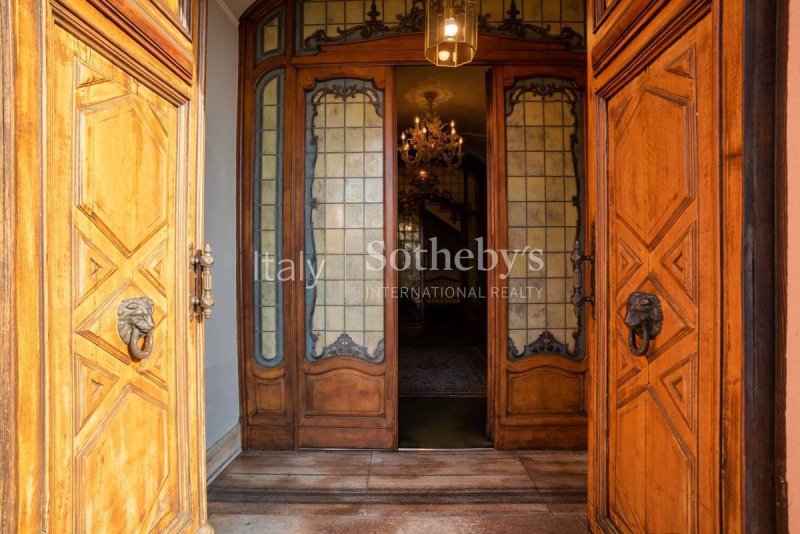In the central area of Omegna, overlooking the lake, an elegant and unique portion of a period building on two levels connected by a very rare white / pink Candoglia marble staircase, extracted from the Candoglia quarries in the municipality of Mergozzo. used also for the Duomo of Milan. The house, rich in construction details, offers large and charming rooms on the ground floor with a private courtyard, while the first floor is reserved for three bedrooms all with private bathrooms, a studio with bathroom and a large closet. The excellent exposure to the sun gives the property a truly unique play of light as an unobtainable feature are the windows and doors of the entire house. The stained glass windows are certainly attributable to the well-known Milanese firm Corvaja and Bazzi both for the particular decorative repertoire and for the unmistakable executive technique of the so-called "émail tubé". The state of conservation is excellent and the glass curbs of the émail tubé show no signs of efflorescence of singenite, the leads are original and the windows are still inserted in the original windows. Considering its characteristics over time, the property was also used as a film set for the 1970s film The Bank of Monate, directed by Francesco Massaro and cast by Walter Chiari.
Язык, с которого был создан автоматический перевод
Nella zona centrale di Omegna, con affaccio diretto a lago, elegante e unica porzione di palazzo d'epoca disposta su due livelli collegati da rarissima scala in marmo di Candoglia, di colore bianco/rosa ,estratto nelle cave di Candoglia nel comune di Mergozzo impiegato nella costruzione anche del Duomo di Milano. L'abitazione ricca di dettagli costruttivi offre ampi e suggestivi locali al piano terra con cortile privato, mentre il piano primo è riservato alla tre camere tutte dotate di bagno privato, uno studio con servizio e un ampi ripostiglio. L'ottima esposizione al sole conferisce alla proprietà un gioco di luci davvero unico in quanto caratteristica introvabile sono le vetrate e le porte di tutta l'abitazione. Le vetrate sono sicuramente attribuibili alla nota ditta milanese Corvaja e Bazzi sia per il particolare repertorio decorativo, sia per la inconfondibile tecnica esecutiva del cosiddetto "émail tubé". Lo stato di conservazione è ottimo e i cordoli vetrosi dell' émail tubé non presentano alcun segno di efflorescenza di singenite, i piombi sono originali e le vetrate sono tuttora inserite nei serramenti originali. L'immobile nel tempo considerato le sue caratteristiche è stato anche utilizzato come set cinematografico per il film anni '70 La banca di Monate, regia Francesco Massaro cast Walter Chiari.
Im zentralen Bereich von Omegna, mit Blick auf den See, befindet sich ein eleganter und einzigartiger Teil eines historischen Gebäudes auf zwei Ebenen, die durch eine sehr seltene weiß / rosa Candoglia-Marmortreppe verbunden sind, die aus den Candoglia-Steinbrüchen in der Gemeinde Mergozzo gewonnen wurde den Bau des Mailänder Doms. Das Haus, das reich an Konstruktionsdetails ist, bietet große und charmante Zimmer im Erdgeschoss mit privatem Innenhof, während der erste Stock für drei Schlafzimmer, alle mit eigenem Bad, ein Arbeitszimmer mit Bad und einen großen Schrank reserviert ist. Die hervorragende Sonneneinstrahlung verleiht dem Anwesen ein wirklich einzigartiges Lichtspiel, denn ein nicht zu erreichendes Merkmal sind die Fenster und Türen des gesamten Hauses. Die Buntglasfenster sind sicherlich sowohl für das besondere Dekorationsrepertoire als auch für die unverwechselbare Ausführungstechnik der sogenannten Email Tubé" der bekannten Mailänder Firma Corvaja und Bazzi zuzuschreiben. Der Erhaltungszustand ist ausgezeichnet und die Glasborde der Emailröhre zeigen keine Anzeichen von Singenitausblühungen, die Bleie sind original und die Fenster sind noch in den Originalfenstern eingesetzt. In Anbetracht seiner Eigenschaften im Laufe der Zeit wurde das Anwesen auch als Filmkulisse für den Film The Bank of Monate aus den 1970er Jahren verwendet, der von Francesco Massaro inszeniert und von Walter Chiari besetzt wurde.
Dans la zone centrale d'Omegna, surplombant le lac, élégante portion d'un immeuble d'époque sur deux niveaux reliés par un escalier en marbre blanc / rose Candoglia, extrait des carrières de Candoglia dans la commune de Mergozzo, utilisé aussi pour la construction du Duomo de Milan. Cette propriété, riche en détails de construction, comprend de grandes et charmantes pièces au rez-de-chaussée avec une cour privée, tandis que le premier étage est réservé aux trois chambres (toutes avec salles de bain privatives), un bureau avec salle de bain et un grand placard. L'excellente exposition au soleil crée un jeu de lumière vraiment unique, car les fenêtres et les portes de toute la maison sont composées de vitraux, certainement attribuables à la célèbre firme milanaise Corvaya et Bazzi, tant pour le répertoire décoratif que pour la technique d'exécution de "l'émail-tubé". L'état de conservation est excellent et les bordures de verre de l'émail tubé ne présentent aucun signe d'efflorescence de syngénite, les plombs sont d'origine et les fenêtres sont encore insérées dans les cadres d'origine. Compte tenu de ses caractéristiques, cette propriété a également servi de plateau de tournage pour le film des années 1970 "La Banque de Monate", réalisé par Francesco Massaro et interprété par Walter Chiari.


